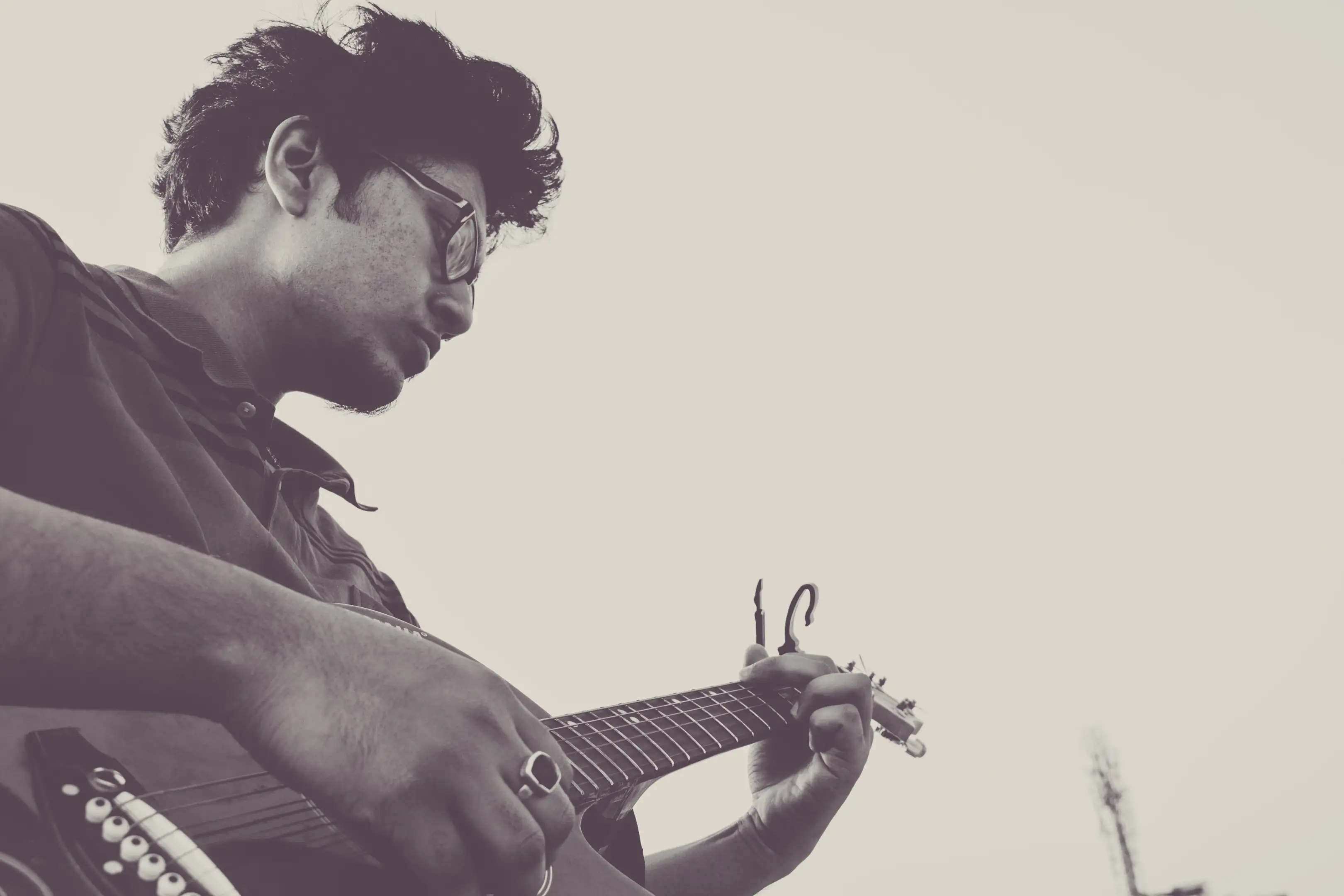Every experienced songwriter has their go-to methods for music, but what if you're just starting out or find yourself running into writer's block? Fortunately, there are plenty of proven songwriting template options to inspire your next song's structure.
Below, we'll delve into the key elements of every hit song, share some common song writing structures and examples, and delve into some helpful tips to help you write your next masterpiece.
Key Elements Every Songwriter Should Know
In order to understand how to write songs, you'll need to be able to channel your ideas into individual music elements. All songs are comprised of the following sections:
Intro
The intro or introductory section is the lead-up to the first verse. This section may introduce musical elements like chord progressions, bass lines, or drum beats, but the singer will usually come in after the introduction.
Verse
The verses of a song are the "meat and potatoes" of a song. These sections typically take up the longest amount of time of a song and provide context and story to the rest of the song.
Pre-chorus
The pre-chorus is a powerful tool that has a unique, clear idea or melody independent from the verse and chorus. As the name suggests, it comes before the chorus but in most cases, after a verse or bridge.
Chorus
The chorus is where you'll hear the main idea of a song.
Hook
The hook is the most memorable part of a song, vaguely explained by the part a listener may get stuck in people's heads. Hooks are short, catchy, and can be within a chorus or outside of it depending on the genre of the music.
Bridge
The bridge is one of the few song elements that isn't necessarily repeated over the course of the song. It's called a "bridge" because it is usually sandwiched in between two choruses, bridging songs together. Bridges are great places to build tension and express new ideas with different melodies, words, or opting to change keys.
Outro
After the final chorus, there may be some sort of a cool down, perhaps with some ad libs or the main vocal slowly dwindling to a fade out.

How Do You Notate Song Structure?
Now that you know the basic song structures, you're ready to use a songwriting template. Song structure can be written out in a variety of ways. In some cases, musicians will write out the name of the song element out in full, as in "Verse Verse Bridge Chorus". In other cases, songs will be notated similarly to poems, with each letter introducing a new sonic element.
A verse chorus verse chorus song could be written as ABAB, with "A" representing the verses and "B" representing the choruses, for instance.
5 Song Structure Templates Every Musician Should Know
You likely already know many of these popular music structures already, but here are several song structures you can use to write your own music or decode your favorite songs.
Verse Chorus Verse Chorus (ABAB)
By far the most common song structure, ABAB structure is short, sweet, and to the point. These songs revolve around having an endlessly catchy chorus or hook.
Verse Chorus Verse Chorus Bridge Chorus (ABABCB)
This form expands upon the classic verse chorus form and draws it out with a bridge. The bridge provides a fresh approach where you can add interest to the story and overall melodies expressed in the song. Taylor Swift's music tends to fit this format to a T, for instance:
Verse Verse Bridge Verse (AABA)
This verse-heavy form lends itself well to different styles of music like folk, country, and singer-songwriter that have a central focus on storytelling. This form provides more room for story, lending itself to deeply personal creations.
Verse Pre chorus Chorus Verse Pre Chorus Chorus (ABCABCC)
The pre-chorus of this song form adds an extra element of memorability with a separate pre-chorus melody. Think of Katy Perry's Firework :
Verse Chorus Verse Chorus Solo Chorus (ABABCB)
Showcased plenty of times throughout rock and pop music, oftentimes the bridge is replaced with an instrumental solo section. The solo section can also provide the opportunity to shift the time signature or key of a song.

5 Songwriting Tips for Complete Beginners
Learning how to write a song doesn't come naturally to everyone, but that does not mean it cannot be done with enough time, patience, and practice. Use these tips to jumpstart your musical exploration as a complete beginner.
Start with a Strong Chord Progression
Not all songs start with a spontaneous melody or lyric idea. If you find yourself getting stuck, start with a killer chord progression . It doesn't have to be complicated in order to be impactful-- most hit song progressions aren't. Work with the I, IV, and V chords in any key of your choice and go from there.
Go Fishing for Ideas
You'll never know when inspiration will strike. We dupe ourselves into thinking that of course we'll remember that idea when it's convenient to write , but in most cases, ideas tend to float away like fish left dangling for too long on a fishing pole. Be proactive and capture things as they come. Even if you can't work on a song immediately, you'll be thankful you captured your ideas when you have the time to sit down and start writing.
Use References and Filter to Find Your Voice
Don't be afraid to use tools to help you with your process! Create a playlist of your favorite songs on streaming platforms and take some time to analyze the song structure - what form seems to come up the most often? You can also use a rhyming dictionary or thesaurus to help you out while you write. Working with other songwriters is also a great way to refine your lyrics and your creative process.
Purge First, Edit Later
It can be challenging to write a song when our inner critic is so loud. Instead of trying to edit and refine your creations as you're brainstorming them, siphon off that critical eye for later. If you don't let your ideas come out, you'll never write anything. Writing music that doesn't meet your expectations is a valid stepping sound to writing music that you are proud of.
Don't Overthink the Process and Make Songwriting a Habit
As with many skills, the biggest blocker to you becoming a great songwriter isn't other songwriters; it's yourself. Try not to take the process too seriously, as difficult as that may be, and trust the process. The more you commit to songwriting (even if that's just 15 minutes a day), the easier it will become. Everyone starts from somewhere.
Songwriting Template FAQs
Making amazing music starts with understanding the foundations of songwriting itself. Here are some commonly asked questions and answers to help you become an expert in common song structure:
How do beginners start songwriting?
Every songwriter starts by diving into the scary territory of the unknown. Ultimately, there is no easy way to learn how to write a song other than doing it. Try not to critique yourself while you're writing the first couple of times and instead focus on finishing songs, regardless of how amateur they may feel.
Do you need to know music theory to write a song?
You do not need to know music theory to write a song but it might help you transition out of using the same chord progression time and time again. Creating intentionally and often can help you learn music theory along the way if you're open to it.
Do you need a professional studio to write a song?
You do not need a professional music studio to learn how to write a song. Many songs start spontaneously in instances that you wouldn't expect-- think of a memorable melody throughout the day? Record it on your phone and save it for later. The more you practice writing songs, the more naturally they will come.
What is the rule of 3 in songwriting?
The rule of 3 speaks to trying to limit your starring elements to 3 at a time during your songwriting process. You don't want to overcomplicate the listening experience by adding too many elements, for instance. New sonic structures will stand out across the relatively static common chord progressions repeated in the background, so use the spotlight with reverence.
What is basic songwriting structure?
One of the most common song structures of popular music is verse chorus form in which a song has a verse and a chorus followed by a second verse and second chorus. This simple formula can help you build a complete song, but don't be afraid to try out your own style.
Can you make a song if you don't play any instruments or sing?
Absolutely! There are plenty of people seeking out instrumental music-- see lofi music, EDM or study music to name a few subsets. Even instrumental music utilizes some of the same sonic structures and elements as typical pop songs.
What is the structure of a song template?
Songwriting templates are typically broken down into common musical elements like verse, chorus, bridge and then distinguished by letters to notate the sections. For instance, ABAB form speaks to a song structure with a verse chorus verse chorus progression.
A songwriting template can certainly help you write songs by giving you a sense of how different music elements work together, but you probably already know much more than you think intrinsically.





